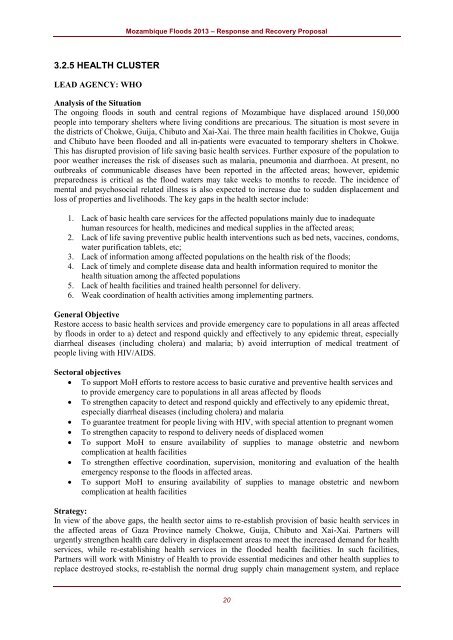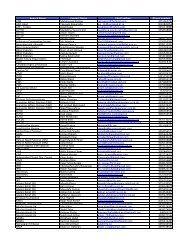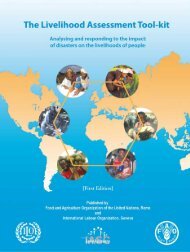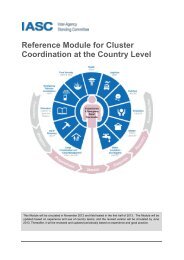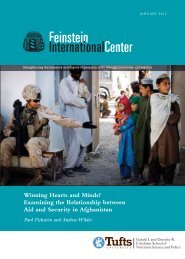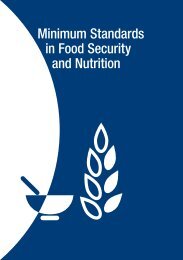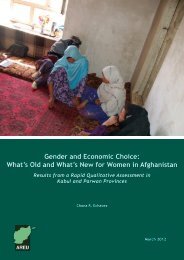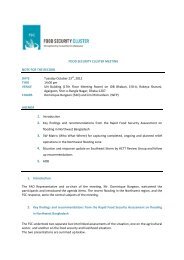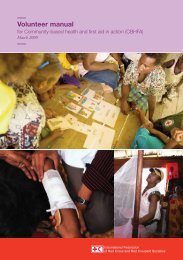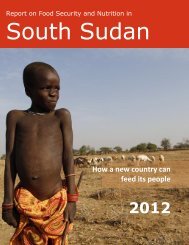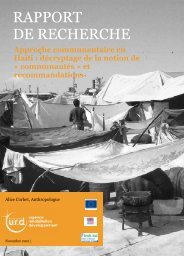Download PDF (1.96 MB) - ReliefWeb
Download PDF (1.96 MB) - ReliefWeb
Download PDF (1.96 MB) - ReliefWeb
You also want an ePaper? Increase the reach of your titles
YUMPU automatically turns print PDFs into web optimized ePapers that Google loves.
Mozambique Floods 2013 – Response and Recovery Proposal3.2.5 HEALTH CLUSTERLEAD AGENCY: WHOAnalysis of the SituationThe ongoing floods in south and central regions of Mozambique have displaced around 150,000people into temporary shelters where living conditions are precarious. The situation is most severe inthe districts of Chokwe, Guija, Chibuto and Xai-Xai. The three main health facilities in Chokwe, Guijaand Chibuto have been flooded and all in-patients were evacuated to temporary shelters in Chokwe.This has disrupted provision of life saving basic health services. Further exposure of the population topoor weather increases the risk of diseases such as malaria, pneumonia and diarrhoea. At present, nooutbreaks of communicable diseases have been reported in the affected areas; however, epidemicpreparedness is critical as the flood waters may take weeks to months to recede. The incidence ofmental and psychosocial related illness is also expected to increase due to sudden displacement andloss of properties and livelihoods. The key gaps in the health sector include:1. Lack of basic health care services for the affected populations mainly due to inadequatehuman resources for health, medicines and medical supplies in the affected areas;2. Lack of life saving preventive public health interventions such as bed nets, vaccines, condoms,water purification tablets, etc;3. Lack of information among affected populations on the health risk of the floods;4. Lack of timely and complete disease data and health information required to monitor thehealth situation among the affected populations5. Lack of health facilities and trained health personnel for delivery.6. Weak coordination of health activities among implementing partners.General ObjectiveRestore access to basic health services and provide emergency care to populations in all areas affectedby floods in order to a) detect and respond quickly and effectively to any epidemic threat, especiallydiarrheal diseases (including cholera) and malaria; b) avoid interruption of medical treatment ofpeople living with HIV/AIDS.Sectoral objectives To support MoH efforts to restore access to basic curative and preventive health services andto provide emergency care to populations in all areas affected by floods To strengthen capacity to detect and respond quickly and effectively to any epidemic threat,especially diarrheal diseases (including cholera) and malaria To guarantee treatment for people living with HIV, with special attention to pregnant women To strengthen capacity to respond to delivery needs of displaced women To support MoH to ensure availability of supplies to manage obstetric and newborncomplication at health facilities To strengthen effective coordination, supervision, monitoring and evaluation of the healthemergency response to the floods in affected areas. To support MoH to ensuring availability of supplies to manage obstetric and newborncomplication at health facilitiesStrategy:In view of the above gaps, the health sector aims to re-establish provision of basic health services inthe affected areas of Gaza Province namely Chokwe, Guija, Chibuto and Xai-Xai. Partners willurgently strengthen health care delivery in displacement areas to meet the increased demand for healthservices, while re-establishing health services in the flooded health facilities. In such facilities,Partners will work with Ministry of Health to provide essential medicines and other health supplies toreplace destroyed stocks, re-establish the normal drug supply chain management system, and replace20


